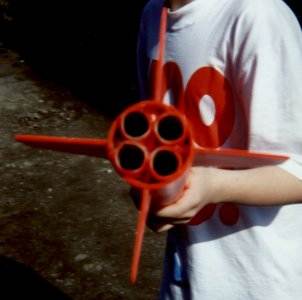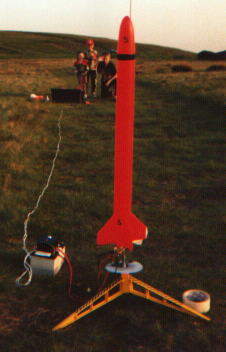Scratch Mark V Original Design / Scratch Built
Scratch - Mark V {Scratch}
Contributed by Darren Longhorn
| Manufacturer: | Scratch |
The MkV was my first cluster design. It's made from a 55mm cardboard postal tube with 1mm thick balsa fins and a balsa nose cone. It's powered by four 18mm engines. They have to be C's . . . really!
 After consulting with the guys on r.m.r I've made a new ignition system. It's based around two 6v lead-acid batteries ( wired in series to give 12v), so I shouldn't have any problems with clustering. The batteries sit very close to the launch pad, so that the clip whips are fairly short. It has two sets of clips to make connection to the four igniters easier. Both the battery station and the remote hand station have keyswitches and red LEDs to indicate when they are active. In addition the hand station has a momentary push button to activate the launch. To keep the diameter of the cable connecting the remote hand station to the battery station down to a manageable size, there is a relay mounted in the battery station. This requires only negligible current to activate. Total parts cost, about £12 excluding the batteries ( which were given to me by Richard 'dodgy contractor' Robinson).
After consulting with the guys on r.m.r I've made a new ignition system. It's based around two 6v lead-acid batteries ( wired in series to give 12v), so I shouldn't have any problems with clustering. The batteries sit very close to the launch pad, so that the clip whips are fairly short. It has two sets of clips to make connection to the four igniters easier. Both the battery station and the remote hand station have keyswitches and red LEDs to indicate when they are active. In addition the hand station has a momentary push button to activate the launch. To keep the diameter of the cable connecting the remote hand station to the battery station down to a manageable size, there is a relay mounted in the battery station. This requires only negligible current to activate. Total parts cost, about £12 excluding the batteries ( which were given to me by Richard 'dodgy contractor' Robinson).
After waiting for several weeks for good weather, the first flight turned out to be a spur of the moment thing. I got home from work one evening and the trees were still. ( There are a group of poplar trees visible from our front room that act as our wind measurement system!). So we packed up and went straight out. Up on Baildon Moor the conditions were perfect, but I was still nervous. This was my first cluster ignition. The technique I had selected was to wire the igniters in a bridge, and then connect two pairs of clips to the four points, equal polarities at opposite corners. It was quite tricky to get the clips on without them or the igniters shorting on the blast deflector. 
Well, a small amount of damage on landing, one cracked fin, that was easily repaired. The parachute ( an Estes one) was not really big enough. The flight had not been straight either, and a quick examination showed that one of the engines had not ignited. I later put this down to a poor twisted connection.
Since then the MkV has flown twice more, but with a larger 'chute. I had wanted a hemispherical one, but ended up with another flat 'chute. It was supposed to be fluorescent orange, but I'd call it pink! This is adequate, but seems to sideslip during descent. If I fly it again I'm going to use the hemispherical 'chute that Karen ( my wife) originally made for the MkVI.
After three flights, the engine mounts and lower fin edges are pretty charred, and I realize that this is due to the flat blast deflector I've been using. An old tin can has now been pressed into service to deflect the blast sideways, and not straight back up. You can see this new deflector in some of the newer pictures ( it shows up quite well on the pic of the Apogee V2).
Sponsored Ads
 |
 |











